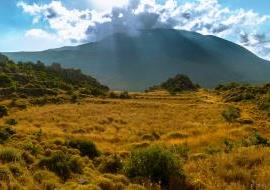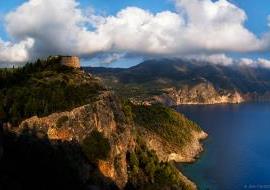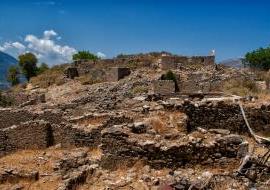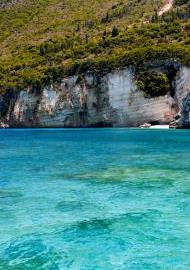Kefalonia is the largest island of the Ionian Sea. Its terrain is mountainous with most of the villages and towns being located either along the coastline or at the foot of mountains. The mountain range of Aenos stands along the southern coastline of the island and its summit reaches 1628 metres while the stunning proximity of the mountainous and islandic nature of this land composes a unique and breath-taking scenery.
The island is counted among the few disputed locations of the Homeric Odysseus's kingdom, yet beyond its ancient and mostly speculative legendary heritage, its relatively recent history is equally or even more important for its contemporary culture. Being part of the Venetian Stato da Mar or else 'the state of the sea' along with most of the other Ionian Islands, Kefalonia was among the principal loci for the expression of Greek culture within the administrative and cultural limits or else—and most aptly in geographic terms—the frontiers of the Western World for several centuries following the dawn of Renaissance. The Ionian Islands became part of the British Empire in the beginning of the 19th century and thus remained until their annexation by Greece in 1864. The ribbon development of most of the local road network of Kefalonia was developed during that period—including the landmark bridge of Argostoli—and it is still in use today.
Through its recent history, Kefalonia is known for its sailing men, since the mountainous terrain of the island naturally forced its inhabitants towards sailing. Notably, among the great Greek poets and infamously known as "the poet of the sea" is the Kefalonian Nikos Kavvadias whose poems became popular through their musical adaptation by Greek artists and have been translated into English.
Kefalonia was virtually destroyed in 1953 by an extraordinarily strong and catastrophic earthquake. Its stone-built buildings—both humble housing and important architectural treasures alike—were destroyed, thus wiping a long part of the architectural heritage of the island, greatly affecting its cultural life, and forcing many of its inhabitants to seek a better future outside the borders of the island, or even abroad. As a bequest and valuable lesson of the catastrophe that was readily adopted in the island, all structures henceforth built in Kefalonia are designed to withstand an earthquake at least as strong at that of 1953.
Through its humble agricultural and sailing history, the Kefalonian culture stands as a discreet yet important part of the Greek heritage. On the other hand, the rough terrain on which its inhabitants were toiling for centuries, is also the source of the beauty of this land, parts of which remain virtually outside the reach of human activities and thus unharmed for those who are willing to appreciate them. In Kefalonia one may enjoy the natural wonders of its unique terrain, walk among the ruins of villages abandoned after the 1953 earthquake, visit the famous and explore the hidden beaches of its coastline, enjoy the finest local products including its well-known and vintage robola wine and thyme honey, and ultimately become an explorer of this land. Else, one may relax and enjoy the Kefalonian hospitality that has largely retained its original character through its discreet and mostly humble development as a tourist destination.





